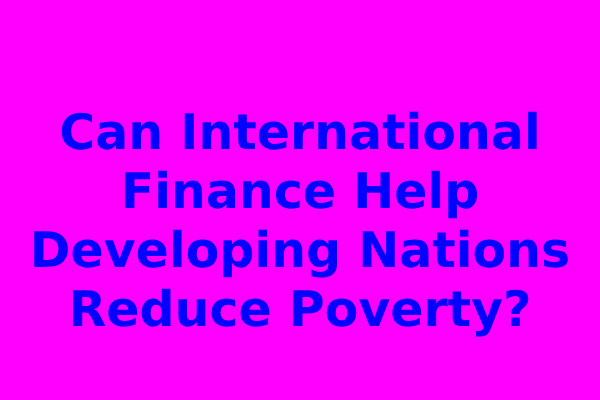Introduction:
In this article, I’ll explore the intricate relationship between international finance and its potential role in alleviating poverty within developing nations. Poverty remains a pervasive and daunting challenge for a significant portion of the global population, particularly in the less economically developed regions of the world. As these nations grapple with limited resources, inadequate infrastructure, and systemic economic disparities, the question arises: can international finance serve as a catalyst for positive change?
International finance encompasses a wide range of instruments, from foreign direct investment and aid to international trade and debt relief initiatives. Understanding how these mechanisms influence economic growth, income distribution, and social well-being in developing countries is of paramount importance. While international finance holds the promise of injecting much-needed capital into struggling economies, its effectiveness in reducing poverty is contingent on various factors, including governance, policy coherence, and the prioritization of poverty reduction in international financial institutions’ agendas. This article will delve into these complexities, shedding light on the potential benefits and challenges that international finance presents in the pursuit of poverty reduction on a global scale.
Role of International Finance
The role of international finance in the context of developing nations’ poverty reduction is multifaceted and pivotal. International finance encompasses a broad spectrum of financial instruments, mechanisms, and institutions that facilitate the flow of funds across national borders. It plays a vital role in supporting economic development and poverty reduction in developing countries. International finance can serve as a conduit for channeling resources from economically developed nations to those in need, thereby enabling developing nations to address their pressing challenges, including poverty alleviation.
One of the primary ways international finance contributes to poverty reduction is through the provision of capital. Developing nations often face a shortage of funds for critical investments in infrastructure, healthcare, education, and social welfare programs. International finance, in the form of foreign direct investment (FDI), loans, grants, and remittances, injects much-needed capital into these economies. FDI, in particular, can stimulate job creation, technology transfer, and skill development, all of which are essential for poverty reduction. Furthermore, international finance institutions like the World Bank and the International Monetary Fund (IMF) provide financial assistance and policy advice to help developing nations manage their economies and implement poverty-reduction strategies effectively.
In addition to capital infusion, international finance promotes economic stability and growth in developing nations. Stable economies are better equipped to reduce poverty, as they create an environment conducive to job creation and income generation. International financial institutions also assist countries in managing financial crises and maintaining macroeconomic stability, which are critical prerequisites for sustained poverty reduction efforts. However, it is essential to acknowledge that the role of international finance is not without its challenges, as it often comes with conditions, which can sometimes lead to unintended consequences and trade-offs in poverty alleviation efforts. Balancing the benefits and risks of international finance is a critical aspect of its role in addressing poverty in developing nations.
Developing Nations’ Poverty Challenges
Developing nations face a multitude of challenges in their quest to reduce poverty. These challenges are often intertwined and deeply rooted in historical, economic, social, and political factors. Understanding these complexities is crucial for formulating effective poverty reduction strategies.
First and foremost, income inequality is a pervasive issue in many developing nations. A significant portion of the population often lacks access to basic necessities, such as food, clean water, education, and healthcare, while a small elite enjoys considerable wealth and privilege. This wealth disparity exacerbates poverty and hinders economic development. Addressing income inequality is a central challenge in poverty reduction efforts.
Moreover, many developing nations grapple with inadequate infrastructure, including transportation networks, energy supply, and sanitation facilities. Insufficient infrastructure limits economic productivity, access to markets, and the delivery of essential services, all of which are vital for poverty reduction.
Additionally, political instability and corruption can hinder poverty reduction efforts in developing nations. Weak governance, lack of transparency, and misallocation of resources can impede the efficient use of international financial assistance and domestic resources. Political instability can disrupt economic activities and deter foreign investment.
Furthermore, developing nations often face vulnerabilities to external shocks, such as fluctuations in global commodity prices, climate change impacts, and health crises. These vulnerabilities can undermine poverty reduction progress, making it essential to build resilience and diversify economies.
Foreign Direct Investment Impact
Foreign Direct Investment (FDI) plays a significant role in the economic development and poverty reduction efforts of developing nations. FDI occurs when a business or individual from one country invests in productive assets in another country, such as factories, infrastructure, or technology. This investment can have several positive impacts on the host country’s economy and its ability to reduce poverty.
Firstly, FDI can stimulate economic growth by increasing investment, creating jobs, and enhancing productivity. When foreign companies establish operations in a developing nation, they often bring advanced technologies, management practices, and expertise. This transfer of knowledge can lead to the development of new industries and the upgrading of existing ones, ultimately contributing to higher economic output and increased income levels.
Secondly, FDI can have a direct impact on poverty reduction by generating employment opportunities. Foreign investors typically hire local labor, providing jobs to the host country’s workforce. This is particularly important in regions with high unemployment rates and limited formal job opportunities. The income earned through these jobs can lift individuals and families out of poverty, improving their standard of living and access to basic necessities.
Additionally, FDI can enhance a nation’s competitiveness in the global market. By integrating with the global economy, developing countries can expand their export capabilities, diversify their sources of revenue, and reduce their dependence on a few sectors or commodities. This economic diversification can enhance resilience to external shocks and contribute to long-term poverty reduction.
However, it’s essential to recognize that the impact of FDI on poverty reduction is not automatic and can vary depending on factors such as the quality of infrastructure, the business environment, and the regulatory framework in the host country. Additionally, there can be concerns related to the exploitation of natural resources, environmental sustainability, and the potential for profit repatriation that must be carefully managed to maximize the benefits of FDI for poverty reduction.
Aid and Assistance Programs
Aid and assistance programs constitute a critical component of international finance’s efforts to reduce poverty in developing nations. These programs involve the transfer of financial resources, goods, services, or technical expertise from donor countries or international organizations to recipients in need. While aid and assistance programs have been instrumental in addressing immediate humanitarian crises, they also play a pivotal role in the broader context of poverty reduction.
One of the primary objectives of aid and assistance programs is to improve access to basic services and necessities in developing countries. These programs often focus on areas such as healthcare, education, clean water, sanitation, and food security. By providing funding and technical support to enhance the delivery of these essential services, aid programs aim to uplift the living standards of impoverished populations.
Additionally, aid programs can serve as a safety net for vulnerable populations in times of crisis. Whether it’s responding to natural disasters, conflict situations, or public health emergencies, humanitarian aid can provide immediate relief and help communities recover from adverse events. This assistance can prevent individuals and families from falling deeper into poverty due to unexpected shocks.
Moreover, development assistance programs can support long-term economic growth and capacity-building in developing nations. Investments in infrastructure, agriculture, and vocational training can empower communities to generate sustainable incomes and reduce dependency on aid over time. These programs often aim to strengthen institutions, promote good governance, and foster inclusive economic development.
However, it’s important to acknowledge the challenges and criticisms associated with aid and assistance programs. Concerns often revolve around issues such as aid dependency, inefficiency, and potential negative effects on local industries. Effective aid delivery requires careful planning, coordination, and monitoring to ensure that resources are used efficiently and that they contribute to lasting poverty reduction.
International Trade Benefits
International trade plays a significant role in poverty reduction efforts within developing nations. Trade involves the exchange of goods and services between countries, and when conducted effectively, it can yield several benefits that contribute to economic growth and poverty alleviation.
One of the key advantages of international trade is the expansion of markets for a nation’s products. Developing countries can access larger and more diverse markets for their goods and services, enabling them to sell their products globally. This market expansion can lead to increased exports, higher production levels, and economic growth, which, in turn, can create job opportunities and raise income levels for the population.
Moreover, international trade can lead to technology transfer and knowledge diffusion. Engaging in trade often requires adopting new technologies, processes, and quality standards to meet international market demands. As developing nations integrate into the global economy, they can gain access to advanced technologies and best practices from more developed trading partners. This knowledge transfer can enhance productivity and competitiveness, further supporting poverty reduction efforts.
Furthermore, trade can promote specialization and diversification in a nation’s economy. Specialization allows countries to focus on producing goods and services in which they have a comparative advantage, leading to increased efficiency and competitiveness. Diversification reduces the reliance on a single industry or commodity, reducing vulnerability to economic shocks and contributing to long-term economic stability.
However, it’s essential to acknowledge that the benefits of international trade are not evenly distributed within a country. Certain sectors and regions may benefit more than others, potentially leading to income disparities. Additionally, trade liberalization can pose challenges for vulnerable industries, which may require targeted policy interventions to mitigate adverse effects.
Debt Relief Initiatives
Debt relief initiatives are a crucial aspect of international finance’s role in poverty reduction for developing nations burdened by unsustainable levels of debt. These initiatives aim to alleviate the financial strain on indebted countries, enabling them to redirect resources toward poverty reduction programs and sustainable development.
Developing nations often accumulate significant external debt through loans from international creditors, including multilateral institutions, bilateral donors, and private lenders. High debt servicing obligations can divert a substantial portion of a country’s budget away from essential services like healthcare, education, and infrastructure, making it challenging to address poverty effectively.
Debt relief initiatives come in various forms, including debt forgiveness, debt restructuring, and concessional lending terms. Debt forgiveness entails the cancellation of a portion or the entirety of a country’s debt, reducing its financial burden significantly. Debt restructuring involves renegotiating the terms of existing debt agreements, often extending repayment schedules or reducing interest rates to make debt servicing more manageable. Concessional lending terms provide loans with favorable conditions, such as low interest rates and extended repayment periods.
One of the most notable debt relief initiatives is the Heavily Indebted Poor Countries (HIPC) Initiative and the Multilateral Debt Relief Initiative (MDRI), led by international financial institutions like the World Bank and the IMF. These initiatives have provided substantial debt relief to many developing nations, allowing them to reallocate resources toward poverty reduction programs and social investments.
However, it’s important to recognize that debt relief is not a one-size-fits-all solution and must be carefully tailored to each country’s unique circumstances. Moreover, debt relief should be accompanied by sound economic and fiscal management to prevent the recurrence of debt crises.
Governance and Policy Coherence
Governance and policy coherence are critical factors that influence the effectiveness of international finance in reducing poverty in developing nations. Strong governance structures, transparent policies, and coordinated efforts are essential for ensuring that financial resources are used efficiently and equitably to address poverty-related challenges.
Effective governance involves the establishment of transparent and accountable institutions at both the national and local levels. It includes measures to combat corruption, promote the rule of law, and ensure that public resources are managed responsibly. Good governance fosters an environment conducive to economic growth, investment, and poverty reduction.
Moreover, policy coherence is crucial to aligning various sectors and policies toward the common goal of poverty reduction. Policies related to trade, investment, healthcare, education, and social welfare should be harmonized to maximize their impact on poverty alleviation. Incoherent or conflicting policies can undermine poverty reduction efforts and hinder progress.
Furthermore, ensuring that international financial assistance is directed toward poverty reduction is essential. Donor countries and international organizations must work together to coordinate their aid efforts and align them with the recipient country’s development priorities. This coordination helps avoid duplication of efforts and ensures that resources are channeled effectively toward poverty reduction programs.
However, achieving strong governance and policy coherence can be challenging in developing nations, as they often face institutional capacity constraints, political instability, and entrenched interests that resist reform. Overcoming these challenges requires long-term commitment, technical assistance, and capacity-building efforts from both domestic and international actors.
Prioritizing Poverty Reduction
The prioritization of poverty reduction within the international finance agenda is a fundamental aspect of addressing poverty in developing nations. Poverty reduction must be at the forefront of policy decisions, financial allocations, and development strategies to ensure that resources are directed toward the most vulnerable populations.
Prioritizing poverty reduction involves setting clear targets and goals for reducing poverty rates and improving the well-being of impoverished communities. These targets can be aligned with international development goals, such as the United Nations Sustainable Development Goals (SDGs), which include specific targets related to poverty eradication.
Moreover, it requires allocating financial resources to programs and initiatives that have a direct impact on poverty reduction. Budgetary allocations should prioritize investments in sectors such as healthcare, education, social protection, and job creation, which are essential for lifting people out of poverty and improving their quality of life.
Additionally, prioritization involves designing policies and interventions that specifically target the most marginalized and vulnerable populations, such as women, children, and marginalized ethnic or minority groups. Ensuring that these groups have equal access to opportunities and services is essential for inclusive poverty reduction.
Furthermore, international financial institutions, donor countries, and development organizations must align their strategies and funding priorities with the goal of poverty reduction. This includes providing financial support and technical assistance to developing nations that are committed to implementing poverty reduction programs and policies.
However, the prioritization of poverty reduction can face challenges, including competing interests and political considerations that may divert resources away from poverty alleviation efforts. It requires a strong commitment from governments, international organizations, and civil society to maintain a focus on poverty reduction as a central objective of development.
Conclusion:
In conclusion, I hope this exploration of the role of international finance in alleviating poverty within developing nations has shed light on the complexities and potential solutions that exist in this critical arena. Throughout this article, we’ve seen how international finance, through mechanisms like foreign direct investment, aid and assistance programs, international trade, debt relief initiatives, and more, can serve as a powerful force for positive change.
However, it is essential to acknowledge that international finance is not a panacea. Its effectiveness in reducing poverty hinges on factors such as governance, policy coherence, and the equitable distribution of benefits. Challenges like income inequality, inadequate infrastructure, and vulnerabilities to external shocks persist in many developing nations, requiring a holistic approach to poverty reduction.
As we move forward, it is imperative that international finance institutions, governments, and stakeholders prioritize poverty reduction within their agendas, allocate resources wisely, and foster an environment of inclusivity and sustainability. By doing so, we can work towards a world where economic growth is not just a statistic, but a tangible path to improving the lives of millions in developing nations, ultimately fulfilling the shared goal of a more equitable and prosperous global society.


